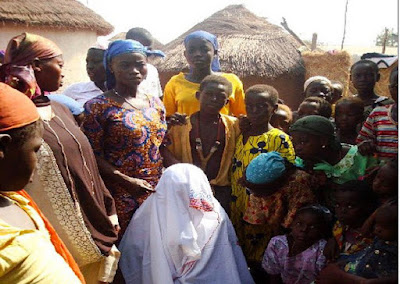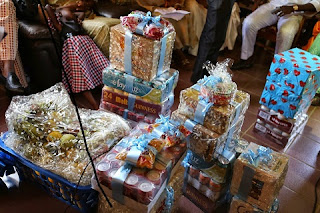"The Epithalamium" Islamic Marriage Ceremony.
The Islamic Traditional Marriage in Ghana
Written By: Kolog Monica Luadanmah(20717)
Written By: Kolog Monica Luadanmah(20717)
Choosing the right partner in marriage is always one of the most essential steps in
human life.
The Islamic marriage life is believed that as a Muslim, you are not supposed to
marry from any religion which is not Islamic. This is mostly done to the Muslim
women and the reason for this discrimination is because as a lady you have to
worship your husband’s religion or obey his religion. And if she refuses then it
becomes “Haram” or a sin.
Even though Muslims are encouraged to follow the teachings of Prophet
Mohammed regarding the specific marriage rites, the marriage rites requirements
from the Islamic community vary from different ethnic groups. However, a typical
traditional marriage in Ghana is the fusion of both ethnic and Islamic rites and
requirements.
The Islamic people always believe that marriage helps to maintain one’s half faith.
Also just as every religion’s reason for getting married which is for
companionship, reproduction, sensuality and assistance. The Islamic religion also
believes that is the reason for them getting married.
The teachings of Prophet Mohammed is always in line with the marriage rites of
the Muslims, though much is depend on the ethnic or traditional background of
which the couple live. However, whichever tribe/ethnic group one belongs to, there
is an apparent commonality in the ways marriage rites are carried out in the Islamic
communities in Ghana.
The following stages outline the marriage rites and how they are being carried out
in the Islamic communities in Ghana. It will also serve as a guard for people who
intend to marry into the Islamic community should expect.
The First Step
The Gaisuwa and Saran
This is the first step in Islamic marriage in Ghana.
With this step, Islam requires that the man has to formally make his intentions
known to the lady’s family (bride to be) and once his proposal is being accepted by
the bride’s or lady’s family. The man is then encouraged to send either his parents
or guardians as well as elderly relatives to formally ask of the lady’s hand in
marriage from her parents, guardians or relatives.
According to the teachings of Prophet Mohammed, the family of the bride to be
have to do a background check on the groom to see if his religious beliefs are
strong, his morals, ethics or if there is any disease in his family and more
importantly his up bringing. The groom family does same but not as always as the
bride.
After a successful investigation, the groom is allowed to see the bride to be for
some short period of time but not in any physical contact like romance and
courting. During this visit, the family of the groom takes along with items such as
sweets, kola nuts and cash (Kudin Gaisuwa).
In Islam, this is the period where the bargain for the bride dowry or price begins.
Muslims believes that the dowry should also be low because the lesser the dowry,
the more blessings will rain in the marriage. The dowry price is called “Sadaki”.
According to the cultural rites of Islam, after accepting the dowry, the family of the
groom sends along items like cooking utensils, scarves, clothes, make-up kits,
pantes and all sorts of things to the bride’s family. The weeding date is then fixed
during the visit and the process of setting the date is called “Saran”.
The wedding date is usually fixed during this visit, by both families. The process
of setting the date is called “Sarana”.
The Second Step– Sa Lalley
This is the second step in the Islamic marriage which is strictly for ladies alone.
The body will be bathed with a mixture of henna, exotic herbs and leaves which
are applied to the lady’s body for sometime.
After sometime, the henna will be washed or whipped off from the lady’s body
with a mixture of perfume in water. After all these activities, some of the henna is
then used to make some beautiful designs on the lady’s palms, hands and legs. The
reason for these designs is to make the bride look more beautiful, eye catching and
also look unique from her mates.
In the olden days, during this process, the family and friends of the bride sing and
dance to the local dialect but in recent times, “Sa Lalley” is seen be partying and
Merry making. The henna will then be used to do designs for the bride’s family
and friends but not as beautiful and deep as the bride’s own.
The Third Step
The Nikah and Walima day (Wedding Day).
The step in Islamic marriage is the “Nikah and Walima” day which is a sacred and
special ceremony that binds a man and a woman together as husband and wife in n
the rightful manner.
In Ghana “Nikah” is performed by a recognized Imam. Before a “Nikah” can be
successful, there are certain conditions which must be performed accordingly.
Firstly, there has to be a guardian. A“Nikah” is not complete without a guardian
from the bride’sside.
Secondly, there must be two witness from both the groom and the bride’s side to
make the “Nikah a successful one.
Thirdly, a dowry must be offered by the groom's family.
Lastly, a valid “Nikah” must be performed in a grand ceremony for everyone and
also have a grand reception to end the wedding. This must include food, water,
drinks and merry making. A price is then set by the bride’s family for the groom to
pay before seeing the bride. And this is called “Kudin Baki”.
The Fourth Step
Budan Kai (Unveiling of the bride)
 |
| families gathered to celebrate the Budan Kai. |
The “Budan Kai” is the final marriage rites in the Islamic Traditional Marriage.
This is the last and final rites where the newly bride is taken to her husband or new
home to be revealed to her new family. “Budan Kai” meaning the unveiling of the
bride. This occasion is always done by the groom’s family to welcome the bride
into her new home and also this exercise takes place after the “Nikah” meaning the
actual wedding day.
The bride is often fully covered up from head to toe so no-one can see her. She
is usually guided by her friends and sisters to where the main unveiling will
take place. She is then brought (still covered) to her husband’s family and one
of his younger sisters/cousins has to then unveil the new bride to her entire
family. The event then rounds up with close relatives praying over and giving
advice to the new couple as they begin their life together. Uncommonly, the
bride is presented with gifts both in cash and in kind during this occasion.
After all these steps has gone through successfully the couple will now be seen
as married couple in the eyes of the society.





Comments
Post a Comment